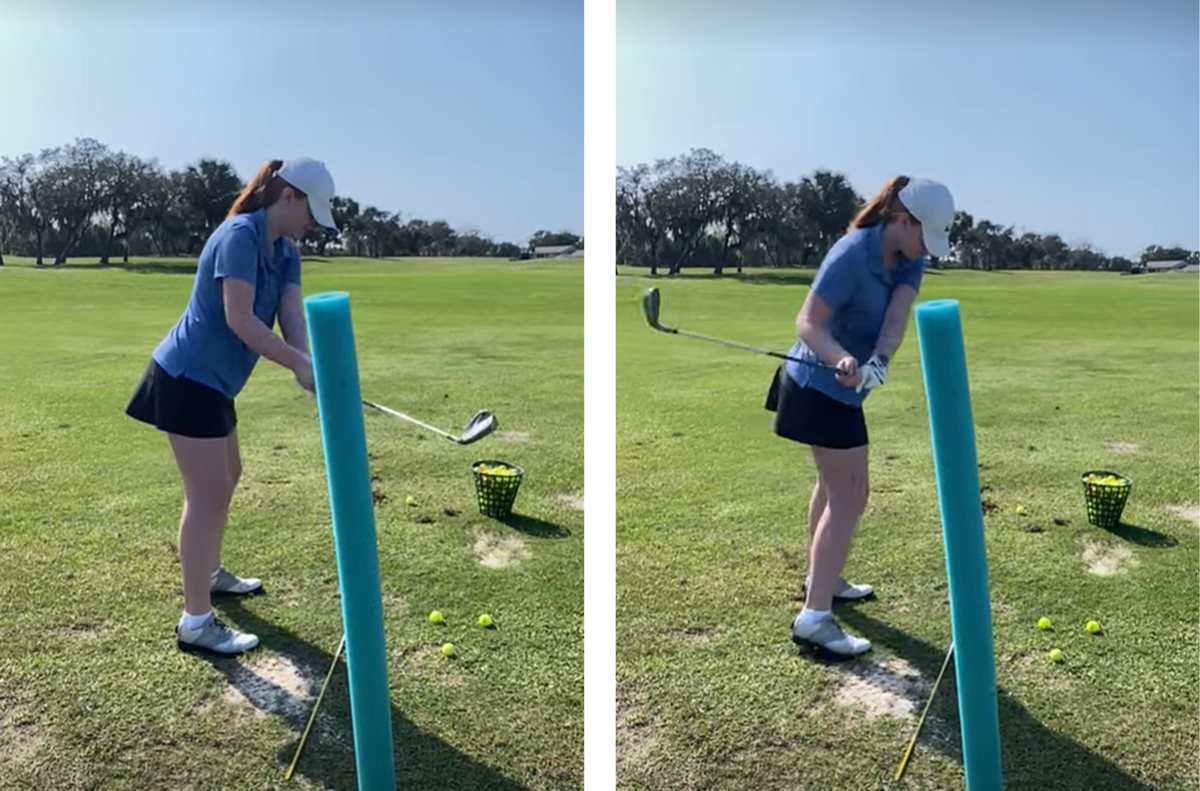How to Shallow the Golf Club
When you learn how to shallow the golf club you'll be come a better, more consistent ball-striker

It's one of those buzz phrases in golf and golf instruction: "Shallowing the Club on the Downswing." You've heard it and may even use it, but do you really know what it means?
Today, you will learn exactly how to shallow the golf club as we explore this trendy term and its meaning, why it's essential, and how to achieve it.
What Does Shallowing The Club Mean?
Shallowing the golf club means flattening it during the downswing. In other words, you are swinging more from the inside and under your backswing plane during your downswing. This is the proper way to swing down from the top of the swing. By shallowing the club, you can hit the ball more solidly and accurately.
Professional golfers have mastered this aspect of the swing, allowing them to hit the ball as solidly as they do. However, for the vast majority of golfers, shallowing the club on the downswing is difficult to master. To have a shallower downswing, you need good pre-swing fundamentals and strong swing mechanics.
Why Shallow the Club on the Downswing?

Here's an illustration of how attacking the ball with a shallower swing creates a more forgiving bottom of the swing and leads to better ball-striking and more consistency.
Shallowing the golf club is key to a proper golf swing. It helps you hit the ball more solidly and accurately. When the club's angle of attack is too steep, it can cause the club to dig into the ground, resulting in either a fat or thin shot. Also, from a swing plane view, the steep downswing causes the famous "over-the-top" path.
Flattening the club's angle of attack allows the club to travel more smoothly through the turf, reducing the chances of mis-hits by super-sizing the bottom of your swing where you can make pure contact.
Shallowing also helps create a more efficient swing, resulting in longer and straighter shots.
Can Shallowing the Club Increase Distance?
Shallowing the golf club can help increase distance and accuracy. Flattening the club allows it to travel smoothly through the turf, resulting in a more efficient swing. This can help generate more clubhead speed, leading to longer shots.
But distance is not the only factor in golf. Accuracy and consistency are also crucial for success on the course. Learning to get shallower on the downswing helps. Swinging from the inside or under the backswing plane helps you become a more solid ball-striker.
How to Shallow the Club on the Downswing

Here's an illustration of how the swing plane is maintained from the address position to the top of the swing
Shallowing the club is a technique that requires practice and patience. It also requires a clear understanding of one of the golf swing's most important fundamental components, The Swing Plane.
The easiest way to describe the concept of swing plane, or the angle at which the club goes back during the backswing, returns down on the downswing, and releases on through to the finish, is through Ben Hogan’s iconic plane of glass. A similar depiction is illustrated above, showing how the swing plane is maintained from the address position to the top of the swing.
As I teach shallowing and the swing plane to my students, you want to imagine a pane of glass that starts at the base of your club's shaft in set-up, runs up through the shaft, and on through your shoulders.
As you swing back, you want to take the club back, in one piece, with your hands and arms, along that pane of glass. As you transition down from the top of your swing, you want your hands and the shaft of the club to travel under that pane of glass. In essence, the club traveling under that pane of glass, or under your backswing plane, is shallowing out the club.
Here are some steps to help you achieve this:
- Start with the proper grip: Hold the club in your fingers, not your palms. Ensure that your left-hand grip is firm and your right-hand grip is light.
- Set up with the proper stance: Address the ball with your feet shoulder-width apart and your weight evenly distributed.
- Begin the backswing: Start the backswing with your arms and shoulders, keeping the club on the correct plane as described earlier.
- Begin the downswing: As you initiate the downswing, your focus must be on bringing the club down on a shallower plane. Imagine skipping a stone across a pond. When you skip a stone, your trail shoulder and elbow naturally "dip" or shallow. With that imagery, your trail elbow will be close to your side, and your hands and club shaft will be under your backswing plane. This is how you shallow the golf club.
- Keep your hands close to your body: As noted above, to shallow the club, you must keep your hands close to your body during the downswing. This will help to flatten the angle of attack.
- Follow through: Continue the swing through the ball and finish with a complete follow-through.
What Shallowing the Golf Club Looks Like

Notice how the club drops underneath the plane in the downswing. This is what shallowing the golf club looks like.
Here is an example of one of my students, Sebastian, and his backswing verse downswing plane. This is a great example of a golfer shallowing the club on the downswing. Notice how close Sebastian’s arms are to his body as he shallows the club on the downswing.
Remember to practice this technique regularly to become comfortable with it. It's essential to have patience and not expect immediate results. With time and practice, you can shallow the club and hit more solid and accurate shots without even realizing you’re doing it.
Drills to Shallow the Golf Club
There are several drills you can use to help you shallow the golf club on the downswing. Here are three drills you can try that I use to teach my students:
- The Range Bucket Drill: Place a range bucket or similar object about a foot (or less if you are daring) to the side of the ball. Focus on hitting the ball without hitting the bucket. This drill will help you keep your hands close to your body which will shallow the club during the downswing.
- The Towel Drill: Place a towel under your armpits and hold it tight with your arms. Focus on making a swing without losing the towel. This drill will help keep your arms and hands close to your body, promoting a shallower club path.
- Out and Under Drill: I use this a lot with my students to help them get a better feel for the shape of the swing and, ultimately, be able to swing from the inside on the downswing.

The Out & Under drill to learn how to shallow the golf club
Poke an alignment stick in the ground about six feet behind the ball and on your target line. Put a pool noodle over the top of that alignment stick to act as a visual. As you take the club back, miss the pool noodle just to the outside of it. On the downswing, your goal is to miss the pool noodle to the inside of it.
Many golfers take the club back too much to the inside on the backswing. This makes it more difficult to shallow the club on the downswing or swing from the inside and under your backswing plane. This drill helps.
I have my students exaggerate this move when we need to “reshape” their swing and get them to swing more shallowly on the downswing.
Shallow the Club for Better Ball-Striking!
Remember to practice these drills regularly to help you develop the muscle memory required to shallow the golf club on the downswing. Over time, you will find that your swing becomes more efficient, and you will hit more solid and accurate shots.